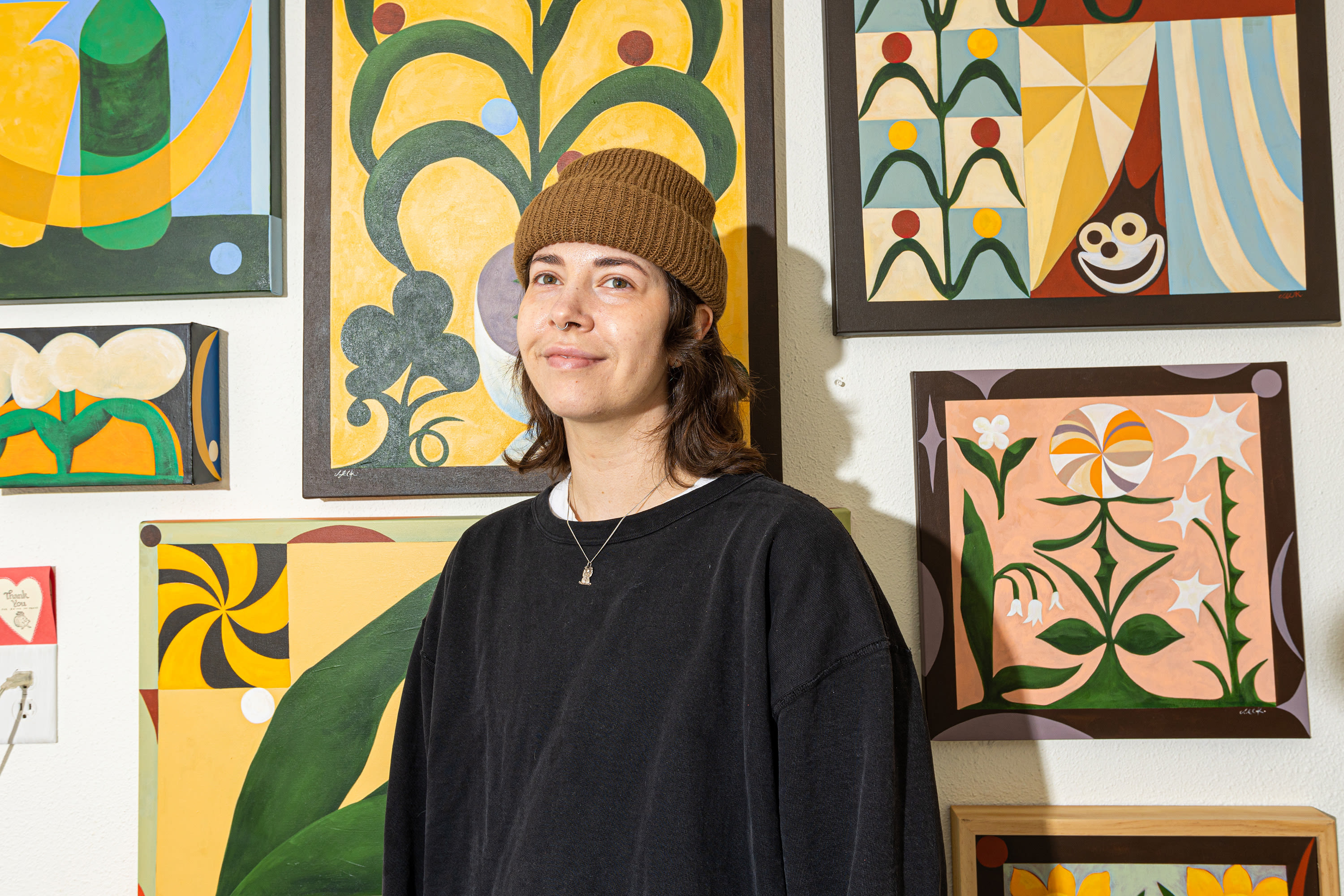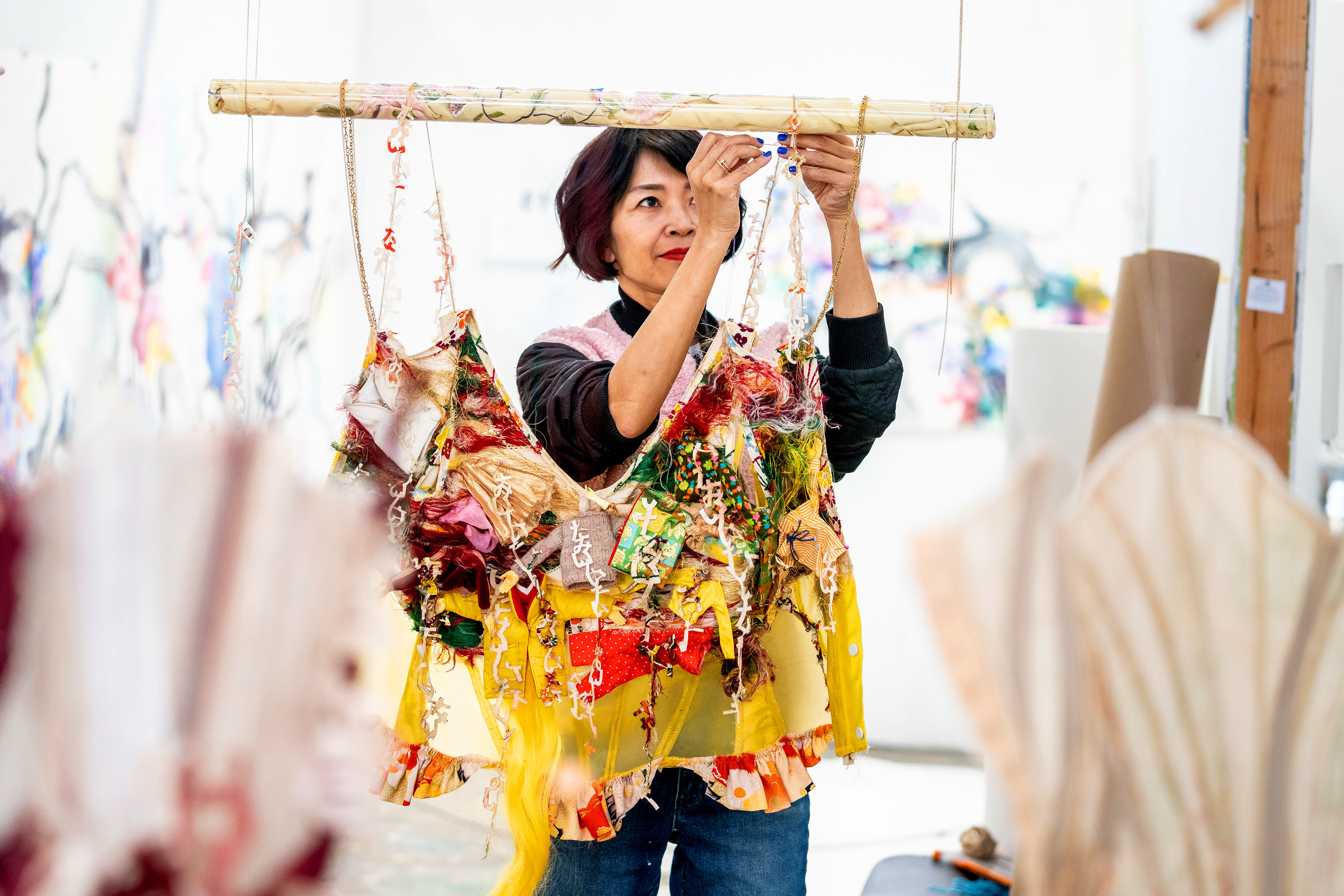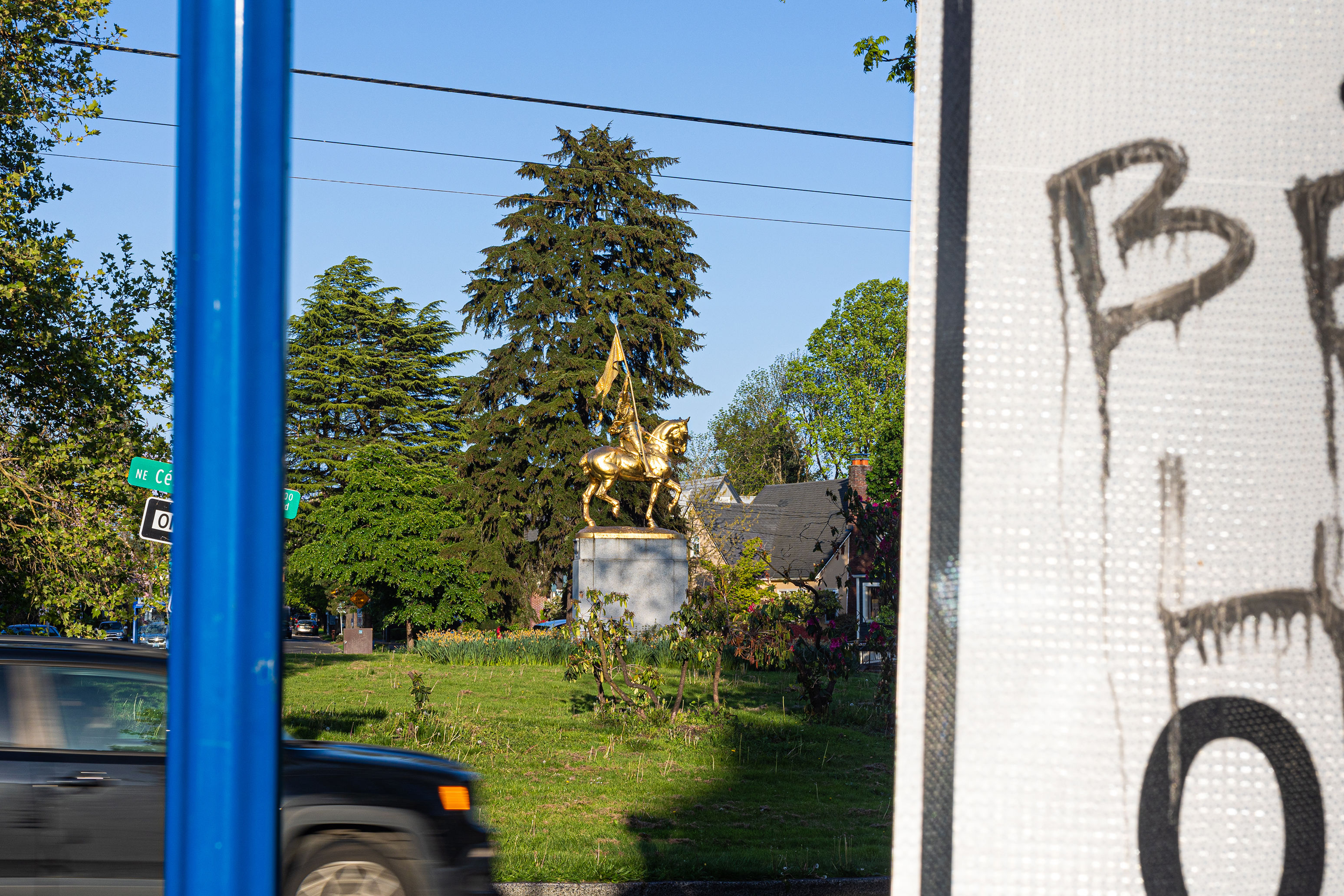
Fall Arts Preview: The New Class
The year 2013 has already brought seismic change to Portland’s cultural landscape. Esteemed leaders retired (we salute you, Artists Rep’s Allen Nause and Portland Piano’s Harold Gray) or moved on (good luck, Oregon Ballet’s Christopher Stowell). Into their seats stepped a new posse of artists and administrators whose worldly résumés signal a new prominence for Portland’s arts scene. “There’s something going on that has people excited,” says Harold Goldstein, who, as the vice chair of the ballet and the chair of Portland Playhouse, helped net two of the recent top hires. “We’re much more visible on the national scene—and people want to be here.”
We invited the new leaders into the photo booth alongside the fabulous fleet of artists they’ll be joining. Consider this the first yearbook of the New Class.
The Idealist
Kevin Kruse, Portland Playhouse
At the end of my interview with Portland Playhouse’s new managing director, Kevin Kruse, I ask, pro forma, if he has anything to add. “Well,” Kruse responds, “you didn’t ask the one question that everybody seems to ask: ‘Are you crazy?’”
Seated on the patio at North Portland eatery Equinox with his beloved dog, Linus, even he admits he might be a bit daft. Kruse left a job as the chief financial officer and director of administration at Cleveland Play House, comparable in size to Portland Center Stage, to take a lower-paying position at the relatively tiny Portland Playhouse. But for this veteran arts administrator, who has held leadership positions everywhere from Walt Disney to San Diego Repertory Theatre, size has never mattered.
“Everybody assumes one’s career is this constant, linear evolution,” Kruse says. “To me, it’s always been about the potential.”
Potential could be a third P in Portland Playhouse’s name. Founded six years ago and housed in a converted Northeast Portland church, the theater has racked up critical accolades for its powerful productions of August Wilson’s plays and adventurous stagings of new works. Crowds have followed the applause, tripling from 4,000 in the Playhouse’s inaugural season to 13,000 in 2012–2013. The theater’s budget grew even more, from $35,000 per annum to almost $800,000, creating new challenges for a leadership more versed in Shakespeare than spreadsheets.
That “unheard-of” budget and attendance spurt was part of why Kruse applied for the managing director job. “It leads you to the question, ‘OK, why?’” he says. “In my experience, it happens because the art’s damn good and you’ve got a group of people who are more motivated than average. Usually, it means you’ve got a charismatic figure in the mix—in this case, Brian [Weaver, the artistic director]. Who isn’t drawn to that?”
Portland Playhouse may be the city’s “it” company now, but the public is fickle. As the theater’s chief pragmatist, a big part of Kruse’s job is planning for the inevitable day when the new glow fades. “We need to be smart to make sure that the resources are in place to build upon our success,” he says.
The Curator
Sandra Percival, Zena Zezza
After 25 years of charting new paths for public art across Washington state and London—and four trying to steer San Francisco’s legendary alt-art venue New Langton Arts through a reinvention and the Great Recession—Sandra Percival returned to her hometown and quickly hit a cul-de-sac. Her initial job as director at the Yale Union (YU) contemporary art center ended after less than two years and only one show. But now she’s striking out on the frontier again with her own new organization, Zena Zezza. The first project, by the internationally renowned artist Josiah McElheny, promises to be both beautiful and intellectually challenging—two ambitions rarely found in so much abundance in one artist’s work.
Percival named Zena Zezza (Zena for short) after her dress-designer grandmother, whose life spanned the entire 20th century, and included brushes with such figures as Peggy Guggenheim. Zena’s mission is to “invert the public art project model,” Percival says, by concentrating not on the final work of art but on the individual artists and the conversations that happen before the making begins and the work moves into the gallery. Without a home to call her own, she was nonetheless able to harness a formidable Rolodex to kick off Zena at the beautiful but underused Lumber Room with an excellent starter: McElheny’s expansive intellect reaches deep into fashion, architecture, cosmology, and cultural history, yet still yields work of breathtaking ethereality.
McElheny recently finished several survey exhibitions and major projects with the likes of Boston’s Institute of Contemporary Art. Meanwhile, his Brooklyn studio was seriously damaged by Hurricane Sandy. Given that, Percival says, he has been looking to 2013 “for thinking.” Thus the exhibition will feature works from projects spanning the past 14 years: works on paper, two films, and four of his otherworldly glass wall pieces that loosely address his interest in 20th-century fashion, from Alexander Rodchenko and Sonia Delaunay to Alexander McQueen.
McElheny will visit Portland to lecture and for a performative conversation called “Interrogating Ideas” with his longtime intellectual soulmate, curator-writer Lynne Cooke (in her own right, a titan of the last 30 years of art, having been curator at both Reina Sofía in Madrid and Dia Art Foundation). “Josiah is revered by artists,” Percival says. “And in Portland, I want to create an artist-to-artist connection. I want to contribute to an expanded view of the art being made here.”
The Principal
Kevin Irving, Oregon Ballet Theatre
As a teen, Kevin Irving lied to his parents about going to CCD, his Catholic church’s weeknight version of Sunday school. Attendance was compulsory in his house. But Ms. Marianne Anderson’s jazz class just happened to be at the same time. Like a fleet-footed Ferris Bueller, he convinced them that he squeezed doctrine, dance, plus SAT prep into the same evening. But mostly he danced.
From Anderson’s studio, Irving graduated to the school of contemporary dance legend Alvin Ailey and a position with another New York contemporary company. In 1985, he pivoted into classical ballet, moving to Montreal and leaping to principal dancer with Les Grands Ballets Canadiens. He may have once hoodwinked his parents into believing he was fleet enough to do it all. Now he actually was, soft-shoeing between contemporary and classical and back as he won high-profile jobs with the art form’s biggest stars: dancer with Twyla Tharp, artistic department head with Nacho Duato’s Spanish company, artistic director for Sweden’s Göteborg Ballet, and frequent guest ballet master with the Royal Danish Ballet.
Irving’s ability to integrate classical and contemporary, combined with his extensive network, made him the top choice for Oregon Ballet Theatre. “We were stunned by the level of applicants,” says Harold Goldstein, vice chair of the board. But Irving stood apart: when the ballet asked candidates for their dream choreographers, “Almost everybody gave the list of people that Kevin knows well personally and would bring,” Goldstein says. (It didn’t hurt that he is also partnered with an OBT visiting favorite, choreographer Nicolo Fonte, particularly given that Irving doesn’t choreograph himself.)
Of course, Irving’s path ahead is hardly paved in palm fronds. The ballet has been wracked by financial woes and executive vacancies that incited a third of the board to try to shut the organization down last fall and then resign when they failed. Shortly thereafter, longtime artistic director Christopher Stowell himself pirouetted away rather than shrink the company.
“We’ve cut to the bone, which I think is a good advantage for me coming in because we’re going to be able to grow organically,” Irving says, adding that they will not replace five dancers who left. “But at the same time, we’ll never lose sight of the fact that part of our obligation is to inspire and entertain the audience.”
For Irving, that involves expanding how the company engages audiences, and he might just bring the right pas de trois of leadership facility, dance pedigree, and global contacts to succeed. “You go in, sit down, the curtain goes up—that whole rote thing is something I want to shake up and reinvigorate,” he says. “I plan on being very creative and thinking out of the box—while respecting our tradition.” —Aaron Scott
The Pianist
Arnaldo Cohen, Portland Piano International
“Let’s call the first victim,” says the Brazilian-born master pianist Arnaldo Cohen with a grin to a packed crowd in the Portland Piano Company in May. A nervous, black-clad boy walks down the aisle to the open piano like he’s approaching the casket at his own funeral. He’s the first of three in Cohen’s master class, part of the spring season of the classical music presenter Portland Piano International.
Cohen sits off to the side, his head craning to watch the 13-year-old play Beethoven’s Piano Concerto no. 2. “You are extremely talented; I want to push you more,” he says at the conclusion, launching into a thorough critique. His face dances as he sings Beethoven’s notes, his love of the music clear. “To practice well is not only playing,” he concludes. “Sing. Look at the score and think how you want it to sound.”
Cohen might give himself the same advice. The very next day, the 65-year-old maestro would walk onto the Newmark stage to give a virtuosic career retrospective of Bach, Brahms, and Chopin that would cap PPI’s 35th season and usher in the organization’s biggest historic change. After a standing ovation, he introduced his first season as PPI’s artistic director, taking the nonprofit over from its founder, Harold Gray.
Since winning the Busoni International Piano Competition in 1972, Cohen has performed on stages the world over. Indeed, his whirlwind weekend in Portland was just a stop between Rio de Janeiro, a short layover at his home in Bloomington, where he is a professor at Indiana University’s prestigious Jacobs School of Music, and Manchester, England, where he is subbing in a symphony performance for Nelson Freire. For this international piano man, leading an artistic organization is one of the few untrod paths.
“Classical music is decreasing in value in our culture,” he says over lunch at Little Bird two days later. “I think increasing its value is an obligation. One of the reasons why I took this challenge is to develop a family that has passion for piano.”
His debut season already takes several steps toward that goal—and reversing PPI’s shrinking subscription base. First, he’s returning the recitals to Lincoln Hall for its greater acoustics and intimacy, and hoping to serve wine afterward so people will stay to talk. Second, he’s doubling most of the recitals so that the pianists perform different programs Sunday afternoon and Monday evening. Finally, he’s leveraging his contacts to bring other international stars, whom he’s cajoling into playing programs slightly outside their current repertoire. “I want very much to use my expertise, my connections, and my passion for education,” he says, “to help create changes of attitude that are like seeds that germinate for future generations.” —Aaron Scott
The Ambassador
Angela Mattox, Portland Institute for Contemporary Art
Pica’s time-based art festival has rarely bowed to artistic convention. But last year, under new artistic director Angela Mattox, TBA kicked convention off the stage. A Mexican company performed historical plays entirely in Spanish, English monoglots be damned. A Serbian artist made a political farce of a word we can’t print. Nora Chipaumire embodied the perceived darkness of Africa by dancing in near blackness.
“Some of this work made people really uncomfortable,” says Mattox. “But the work is not just to entertain people. I’m curating things that will generate a strong response—that will surprise and have a social and political impact. I think it’s important for Portland to engage with the world.”
Mattox first serrated her tough-love global aesthetic in the late ’90s at UCLA’s World Arts and Culture program, then went on to become the grant coordinator for one of the country’s leading cultural exchange organizations. In 2003, she leapt to San Francisco’s noted avant-garde Yerba Buena Center for the Arts, where she quickly rose to lead curator in performing arts. She’s part of a small cadre of curators who can still cobble together resources for the travel and paperwork necessary to find and bring non-Western performers to the US.
Now riding PICA’s new focus on year-round programming, new capacity as a re-granting organization thanks to large awards from two foundations, and new home base for TBA (a raw Northwest Portland warehouse), Mattox plans to spin the globe even faster. Early steps: joining the Africa Contemporary Arts Consortium and launching a national pilot program called Field Guide that aims to help small groups understand a given dance performance by guiding them through a pre-show workshop, the performance itself, and a post-show, drink-fueled discussion.
“She has a very different artistic vision than the past TBA curators, and that’s good,” says Walter Jaffe, cofounder of dance presenter White Bird and one of Mattox’s longtime colleagues. “Some curators pick individual artists on individual strengths, but Angela has a more overarching vision. Everything makes sense as a piece of a whole.” —Aaron Scott
Dive into PICA's Time-Based Art Festival
- Jamie Isenstein: Aug 27–Oct 20 Rising New York artist (and Portland native) Isenstein puts herself into her work—literally. Many of the installations in this survey show involve her sustained presence in feats of artistic endurance, such as remaining hidden in a wall for hours with only her hand protruding. When she’s not there, she hangs a “will return” sign. We suspect we will return, too—several times.
- Campo: Sept 13–14 Emblematic of many of this year’s stripped-down performances, Belgian dancer Pieter Ampe and Portuguese artist Guilherme Garrido create a performance that relies on nothing but their bodies and a profound level of trust (not even clothes—much of the performance is naked). In this US premiere, they shift between tenderness, humor and aggression while pushing male bonding to the extreme.
- Trajal Harrell: Sept 13–15 This New York dancer made international waves with his five-part series exploring a hypothetical question: what would have happened in 1963 if Harlem’s extravagant gay ball scene (the originators of voguing) had intersected with the minimalist postmodern dance scene downtown? The answer, according to the New York Times, is “seductive, seditious, [and] subversive.”
- Meow Meow and Thomas Lauderdale with the Oregon Symphony: Sept 14 The artistic love affair between Pink Martini bandleader Thomas Lauderdale and globe-scorching cabaret diva Meow Meow went from TBA:2005 to the Sydney Opera House and back. Don’t be surprised if Meow Meow is the first person you ever see crowd surfing in the Schnitz.
- Third Angle New Music Ensemble: Sept 17–19 Known for performing in unlikely venues—an office building, a fountain, a porch—the Portland-based new music ensemble plunges into pitch darkness at the OMSI Planetarium to perform Georg Friedrich Haas’s String Quartet no. 3, which the Los Angeles Times called “mind-blowingly good.”
The Humanist
Adam Davis, Oregon Humanities
Adam Davis had a room in the ivory tower with his name on it—but he didn’t like the view. The new executive director of Oregon Humanities earned a doctorate in political philosophy from the University of Chicago in 2003, putting him solidly on the academic track. But Davis knew before his dissertation was done that he didn’t want the scholar’s cloistered life.
“I wanted to be doing something that felt more engaged,” he says.
So Davis took his love for knowledge out into the world. He cofounded a nonprofit that offers programming for underserved youth in Chicago and then became the director of the Center for Civic Reflection, a nationally recognized organization that leads discussions in all corners of society—and, under Davis’s watch, has trained thousand of facilitators to lead them, too. But after nine years on the job, he felt he wasn’t learning anymore. For people and organizations that trade in ideas, intellectual stagnancy spells doom.
So in August, he took the reins at Oregon Humanities, the 42-year-old Portland-based nonprofit that takes the thought-provoking discussions you might hear in a literature, history, or philosophy seminar off campus and into the commons. The organization publishes a magazine; offers a free, college-level humanities course for low-income adults; and hosts the popular “Think & Drink” happy-hour speaker series, among other programs.
Oregon Humanities Board Chair John Frohnmayer says the executive-director search committee unanimously recommended Davis largely because of his track record as a mediator. “He’s very skilled at focusing groups on the ‘why’ of the issue as opposed to the ‘how,’” Frohnmayer says. “That’s important because where we end up throwing spitballs at each other in our society is in the details of how we get to common goals.”
Under its last executive director, Cara Ungar, Oregon Humanities underwent major changes—most notably branding guru Jelly Helm’s recasting of the nonprofit’s dry name, the Oregon Council for the Humanities, into Oregon Humanities and the onomatopoeic abbreviation O. Hm., “the sound of hearing a new idea.” Looking forward, Davis predicts that the greatest obstacles for the 10-employee organization, as with many smaller nonprofits, will be financial. “The programs themselves are quite strong,” he says. “The challenge is around the conditions that allow the programs to flourish.”
That means building an endowment, which the organization is in the early stages of doing. But in a larger sense, to Davis, it means turning Oregon into the same kind of laboratory for new approaches to the humanities as the state has been for health care, transportation, and urban planning.
“O. Hm.’s business,” he says, “is, in a very concrete way, hope for the future.”




